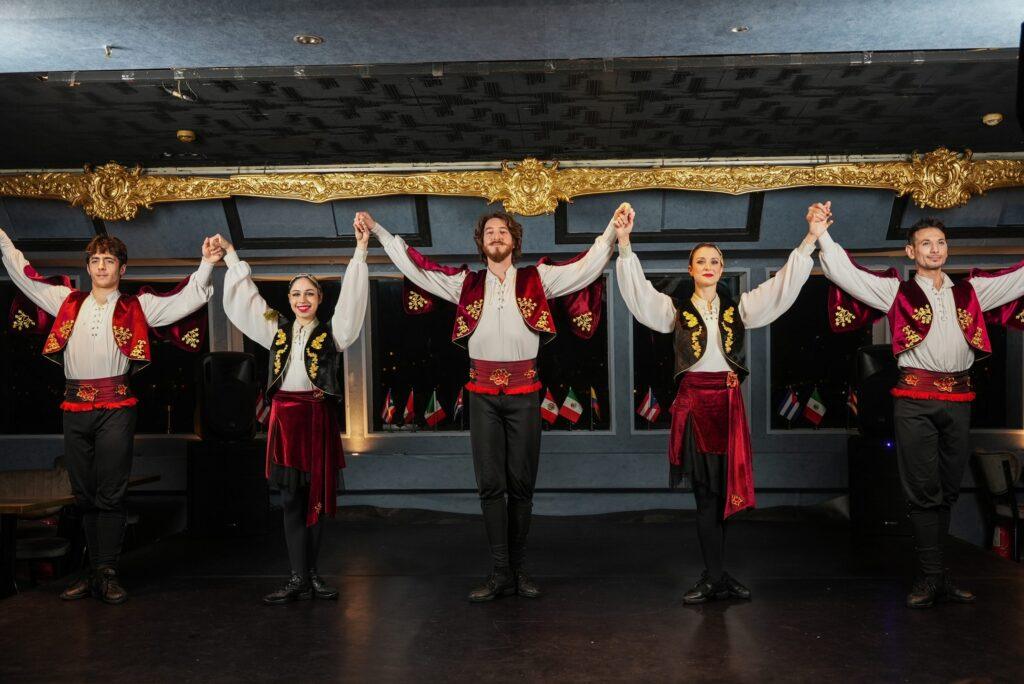
Turkey, a country with a diverse and vibrant cultural heritage, boasts a wide array of traditional dances that reflect its rich history and regional diversity. Each dance has its unique characteristics, often tied to the historical, social, and cultural context of the region from which it originates. This article explores some of the most prominent Turkish cultural dances, highlighting their origins, features, and significance.
Folk Dances
Horon
Region: Black Sea Region
Characteristics: Horon is known for its fast-paced and energetic movements, typically performed by both men and women. Dancers hold hands and form a circle, moving rhythmically to the beat of traditional instruments such as the davul (drum), zurna (reed instrument), and kemençe (a type of fiddle). The dance is a symbol of unity and community, reflecting the robust and lively spirit of the Black Sea people.
Zeybek
Region: Aegean Region
Characteristics: Zeybek is a proud and slow-paced dance predominantly performed by men. It symbolizes the bravery and heroism of the Zeybek warriors, who were known for their resistance against oppressors. The dance features distinctive movements such as kneeling and arm gestures, representing the nobility and courage of these warriors. The music accompanying the Zeybek is often melancholic and deeply emotional, played with instruments like the bağlama (a stringed instrument) and the clarinet.
Halay
Region: Eastern and Southeastern Anatolia
Characteristics: Halay is a communal dance performed in a line or circle, with participants holding hands or shoulders. It is typically accompanied by the rhythmic sounds of the davul and zurna. The dance steps involve intricate footwork and shoulder movements, symbolizing solidarity and cooperation among the dancers. Halay is often performed during celebrations, weddings, and festivals, making it a vital part of social gatherings.
Bar
Region: Erzurum and surrounding areas
Characteristics: Bar dances are characterized by their solemn and stately movements. Dancers line up close to each other, executing slow, deliberate steps that convey a sense of strength and dignity. The dance is performed to the accompaniment of traditional instruments like the davul and zurna. Bar dances often reflect themes of nature, heroism, and social values, making them a significant cultural expression in the region.
Sema
Region: Konya and the Mevlevi Order
Characteristics: Sema is a spiritual and ritualistic dance performed by the Mevlevi dervishes, followers of the Sufi mystic Rumi. It involves a whirling motion where dervishes, dressed in white robes, spin gracefully to achieve a state of spiritual ecstasy and union with the divine. The dance is accompanied by the ney (a reed flute) and kudüm (a type of drum), creating a meditative and transcendental atmosphere. Sema is not just a dance but a form of worship and meditation, reflecting the deep spiritual roots of Turkish culture.
Çiftetelli
Region: Nationwide
Characteristics: Çiftetelli is a lively and joyous dance performed during weddings and celebrations. It can be danced by both men and women, often featuring playful and flirtatious movements. The dance is accompanied by upbeat music played with instruments such as the davul and clarinet. Çiftetelli is known for its energetic steps and improvisational style, allowing dancers to express their joy and exuberance freely.
Kaşık Oyunları
Region: Central Anatolia and Mediterranean Region
Characteristics: Kaşık oyunları, or spoon dances, involve dancers using wooden spoons to create rhythmic sounds as they dance. The dancers hold the spoons in their hands, clapping them together while performing coordinated movements. This dance is often accompanied by folk music played on instruments like the bağlama and zurna. Kaşık oyunları are a testament to the creativity and resourcefulness of Turkish folk culture, turning everyday objects into instruments of art.
Kafkas Dansı
Region: Northeastern Anatolia and Caucasus
Characteristics: Kafkas dansı, or Caucasian dance, is known for its fast, athletic movements and intricate footwork. It is a dance of strength and agility, often performed by men and women separately. The dance is a showcase of bravery and vigor, with performers executing jumps, spins, and dynamic steps. Instruments such as the accordion and davul provide the rhythmic backdrop for this visually striking dance.
Modern and Popular Dances
Oryantal Dans
Region: Nationwide
Characteristics: Also known as belly dancing, oryantal dans is primarily performed by women and features graceful, fluid movements of the hips and abdomen. This dance is a staple at weddings, parties, and entertainment venues. It is accompanied by lively and rhythmic music, often played with instruments like the darbuka (a type of drum) and oud (a stringed instrument). Belly dancing is not only a form of entertainment but also an expression of femininity and elegance.
Tango
Region: Major cities across Turkey
Characteristics: Introduced to Turkey in the early 20th century, tango has become especially popular in large urban centers like Istanbul. This dance, originally from Argentina, is characterized by its passionate and dramatic movements. Couples dance closely together, performing intricate steps and dips to the accompaniment of melodic tango music. Turkish tango combines traditional elements with local musical influences, creating a unique fusion that is enjoyed by many.
Conclusion
Turkish cultural dances are a vibrant reflection of the country’s rich history and diverse regional identities. From the energetic and communal Horon of the Black Sea to the solemn and spiritual Sema of the Mevlevi dervishes, each dance tells a story of the people and the land. These dances not only serve as a form of entertainment but also play a crucial role in preserving and celebrating Turkish cultural heritage. Whether performed at weddings, festivals, or in intimate gatherings, Turkish dances continue to be a vital and dynamic part of the nation’s cultural fabric, connecting past traditions with contemporary expressions.